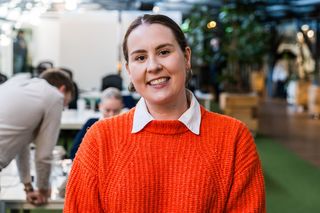Obituary: Mary Maher, feminist, ‘Irish Times’ Woman’s Editor, lifelong socialist and trade union activist
Mary Maher, centre, with colleagues. Picture by Collins Agency
Last week, Mary Maher, one of the key founding members of the Irish Women’s Liberation Movement, Irish Times Woman’s Editor, author, lifelong s ocialist and trade union activist slipped away. As fellow founder Máirín de Burca said: “One of the great feminist lights has been extinguished.” She was 81.
I knew Mary best in the heady days of the 1970s, when “Ireland was finding its soul”. Activism was everywhere.
Máirín de Burca, in prison for egging Nixon, thought: we’re fighting for everyone else’s rights, so why don’t we fight for our own?
American sisters had come to the same conclusion. Fed up carrying guns, rolling joints and making tea for ‘the brothers’, they determined on a movement that would be theirs. Second Wave Feminism was born
Mary Maher, luminously beautiful and intelligent, fresh from Chicago, was in a similar frame of mind. When Máirín got out of prison, she, Mary, Mrs Gaj, Moira Woods and Máirín Johnston arranged to meet in Bewley’s. Over tea and sticky buns, the Women’s Movement — the IWLM — was born.
Mary was then editor of the new Women’s Page in the Irish Times. Initially appalled at the idea, “women’s pages are run by 45-year-old women in hats”, editor Donal Foley persuaded her he wanted a page with “serious articles, scathing social attacks and biting satire”.
Mary got stuck in, gathering a brilliant team — Maeve Donnellan, Nell McCafferty, Renagh Holohan, Christina Murphy, Mary Cummins, Elgy Gillespie, Maeve Binchy. Everything was up for scrutiny — homelessness, beating kids in schools, unequal pay, contraception, the decades long, dead-hand grip of the Catholic Church.
Women’s pages in the Independent and the Irish Press soon followed. They became the place where everything was happening. Mary Kenny was photographed in front of a poster: “If it’s Tame, it’s not Today.” That was the zeitgeist.
The pages also became vital to the Women’s Movement. Not only were the editors — Mary Maher in the Irish Times, Mary Kenny in the Irish Press, and Mary McCutcheon in the Independent — good friends, all were members of the IWLM. We went out and made the news, then we came back to our desks and wrote about it.
Within the IWLM, as well as being “a bridger of divides”, a vital skill among a group of furiously opinionated 20- and 30-somethings, Mary was the key driver behind our seminal booklet — Chains or Change.
It was the first time since the State’s foundation that women’s situation had been examined. It was dire. Every single category we looked at — education, jobs, marriage — women were systematically marginalised, underpaid, badly educated. Our ‘best’ option was to marry, often the only realistic one, upon which you became a ‘chattel’ or a possession of your husband’s along with his tractor/car/house.
And marriage was precarious. If your man got fed up he could split and head for the UK, where he could divorce you, get full custody of the children, and the family home. All legally.
Girls were not taught maths, certainly not higher maths, so good jobs with good money and security were closed to them. Accountancy, engineering, science, medicine, veterinary medicine, airline pilots, police inspectors, bank managers, newspaper editors, compositors, lawyers, not to mention judges, surgeons, technicians, higher civil servants — all closed to girls.
As for contraception, unless you lived in Dublin and knew a sympathetic doctor, you could forget it. We didn’t even dare mention abortion.
Mary contributed a special section: 5 Reasons to Live in Sin, her carefully modulated language masking rage. Not marrying meant: 1) you kept your job, even if you had babies; 2) your income tax was not bundled in with hubby’s, losing you all your benefits; 3) you kept your business identity, meaning you could use hire purchase, open a bank account, get credit; 4) if you got fed up you could walk away, whereas if you were married and walked away the hubby got everything; 5) you got to be an equal in an adult relationship, not a chattel tied to her man.
Mary’s other key achievement within the movement was organising the "Contraception Train" to Belfast. Ironically, given its mission — to go North, buy contraceptives, return and brandish them at Customs, daring them to arrest us — Mary couldn’t go. She was pregnant and her waters broke on the morning of May 22 as the train steamed out of Connolly Station.
“The Train” — a brilliant piece of direct action — was captured for TV, thanks to Mary ensuring it took place on World Media Day.
Of course, this being Ireland it would be another 22 years before full legal contraception was introduced, but “The Train” and Chains or Change put feminism on the map. Everyone was talking about it. Including the bishops, who denounced us from the altar: Harridans. Harlots. Disgraces to Womanhood. Animals, etc.
Sadly, after the IWLM broke up we went our separate ways.
Mary of course went on to have other lives. She had her two babies, Maeve and Nóra. Now grown up and with lots of grandbabies. Níon, Kit and Finn.
She stayed with the Irish Times for 36 years, never wavering in her feminism.
She was the first woman there to return to work after getting married. The first to get paid maternity leave. The first to become lead in the NUJ, insisting ‘Father of the Chapel’ should be changed to ‘Mother’. As long-time friend and colleague Séamus Dooley said, she “broke the glass ceiling of the Irish Times chapel with a firm thud of her stiletto”.
She never wavered either in her work for trade unions, working with the NUJ, Ictu, the Employment Appeals Tribunal and the Legal Aid Board.
She was also a brilliant singer, one of her favourites being the feminist anthem, Bread and Roses, “As we go marching, marching, in the beauty of the day… For the people hear us singing: Bread and Roses! Bread and Roses!”
Her last years were not easy. She had worked so hard. Given so much. She was exhausted. The last time I saw her she was walking along with her beloved sister Bonnie by Belgrave Square; frail and on crutches, she still had that trademark piercing look, that awareness, that kindness.
Here’s hoping showers and showers and showers of roses are following her into the great beyond.
Rest in Power, Sister.
Join the Irish Independent WhatsApp channel
Stay up to date with all the latest news














